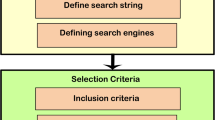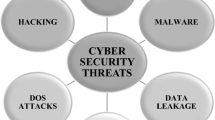Abstract
Deep Learning (DL) has been widely adopted in the domain of cybersecurity to address a variety of security and privacy concerns. Moreover, in recent years attackers are also increasingly adopting deep learning to either develop new sophisticated DL-based security attacks, such as Deepfakes. Recently Deepfake technology is used to spread misinformation on social networking. Currently, the most popular algorithm for deepfake image generation is GANs. The goal of this paper is to adopt DL-based smart detection techniques to defend against smart misinformation. We develop a set of hands-on labs to integrate them in our cybersecurity curriculum so that our students, future cybersecurity professionals, can be educated to use detect software and identify Deepfakes. Finally, we will investigate the fundamental capabilities, challenges, and limitations of deep learning for detecting smart attacks.
Access this chapter
Tax calculation will be finalised at checkout
Purchases are for personal use only
Similar content being viewed by others
References
Agarwal, S., Farid, H., Gu, Y., He, M., Nagano, K., Li, H.: Protecting world leaders against deep fakes. In: Proceedings of the IEEE Conference on Computer Vision and Pattern Recognition Workshops, pp. 38–45 (2019)
Albahar, M., Almalki, J.: Deepfakes: threats and countermeasures systematic review. J. Theor. Appl. Inf. Technol. 97(22), 3242–3250 (2019)
Chi, H., Aderibigbe, T., Granville, B.C.: A framework for IoT data acquisition and forensics analysis. In: 2018 IEEE International Conference on Big Data (Big Data), pp. 5142–5146. IEEE (2018)
Güera, D., Delp, E.J.: Deepfake video detection using recurrent neural networks. In: 2018 15th IEEE International Conference on Advanced Video and Signal Based Surveillance (AVSS), pp. 1–6, November 2018
Huang, Y., Juefei-Xu, F., Wang, R., Guo, Q., Ma, L., Xie, X., Li, J., Miao, W., Liu, Y., Pu, G.: Fakepolisher: Making deepfakes more detection-evasive by shallow reconstruction. arXiv preprint arXiv:2006.07533 (2020)
Iperov. iperov/deepfacelab, January 2020
Maras, M.-H., Alexandrou, A.: Determining authenticity of video evidence in the age of artificial intelligence and in the wake of Deepfake videos. Int. J. Evid. Proof 23(3), 255–262 (2019)
Newman, L.H.: To fight Deepfakes, researchers built a smarter camera, May 2019
Nguyen, H.H., Yamagishi, J., Echizen, I.: Capsule-forensics: using capsule networks to detect forged images and videos. In: ICASSP 2019-2019 IEEE International Conference on Acoustics, Speech and Signal Processing (ICASSP), pp. 2307–2311. IEEE (2019)
Nguyen, T.T., Nguyen, C.M., Nguyen, D.T., Nguyen, D.T., Nahavandi, S.: Deep learning for deepfakes creation and detection. arXiv preprint arXiv:1909.11573 (2019)
Shen, T., Liu, R., Bai, J., Li, Z.: “deep fakes” using generative adversarial networks (GAN) (2018)
Soceanu, A., Vasylenko, M., Gradinaru, A.: Improving cybersecurity skills using network security virtual labs. In: Proceedings of the International MultiConference of Engineers and Computer Scientists 2017 Vol II, IMECS (2017)
Tariq, S., Lee, S., Kim, H., Shin, Y., Woo, S.S.: Detecting both machine and human created fake face images in the wild. In: Proceedings of the 2nd International Workshop on Multimedia Privacy and Security, pp. 81–87. ACM (2018)
Tolosana, R., Vera-Rodriguez, R., Fierrez, J., Morales, A., Ortega-Garcia, J.: Deepfakes and beyond: A survey of face manipulation and fake detection. arXiv preprint arXiv:2001.00179 (2020)
Verdoliva., L.: Media forensics and deepfakes: an overview. arXiv preprint arXiv:2001.06564 (2020)
Vincent, J.: Deepfake detection algorithms will never be enough, June 2019
Wahsheh, L.A., Mekonnen, B:. Practical cyber security training exercises. In: 2019 International Conference on Computational Science and Computational Intelligence (CSCI), pp. 48–53. IEEE (2019)
Xu, W., Yan, J., Chi, H.: A forensic evidence acquisition model for data leakage attacks. In: 2019 IEEE International Conference on Intelligence and Security Informatics (ISI), pp. 53–58. IEEE (2019)
Author information
Authors and Affiliations
Corresponding author
Editor information
Editors and Affiliations
Rights and permissions
Copyright information
© 2021 Springer Nature Switzerland AG
About this paper
Cite this paper
Chi, H., Maduakor, U., Alo, R., Williams, E. (2021). Integrating Deepfake Detection into Cybersecurity Curriculum. In: Arai, K., Kapoor, S., Bhatia, R. (eds) Proceedings of the Future Technologies Conference (FTC) 2020, Volume 1. FTC 2020. Advances in Intelligent Systems and Computing, vol 1288. Springer, Cham. https://doi.org/10.1007/978-3-030-63128-4_45
Download citation
DOI: https://doi.org/10.1007/978-3-030-63128-4_45
Published:
Publisher Name: Springer, Cham
Print ISBN: 978-3-030-63127-7
Online ISBN: 978-3-030-63128-4
eBook Packages: Intelligent Technologies and RoboticsIntelligent Technologies and Robotics (R0)




